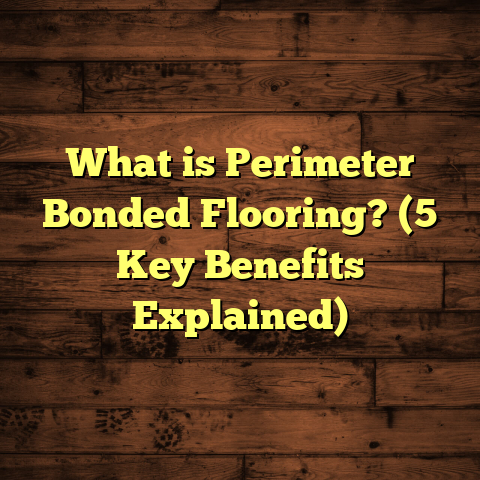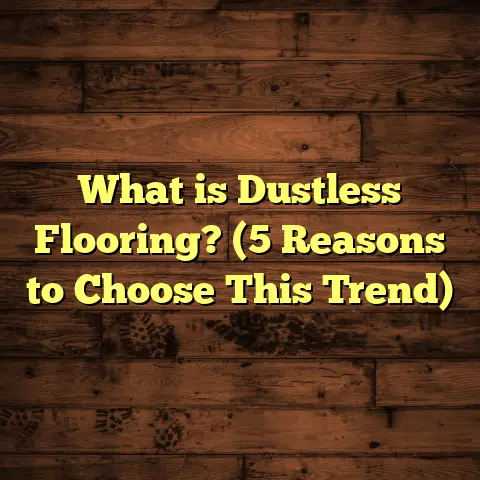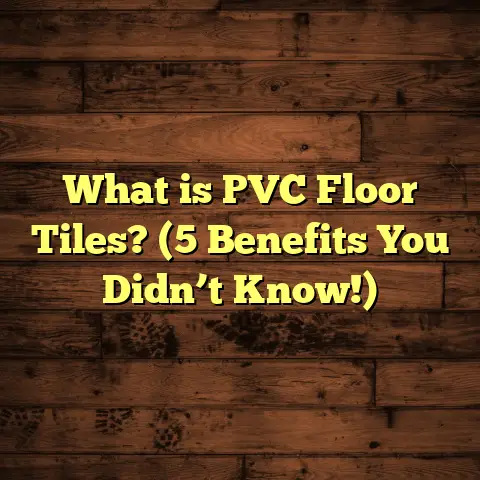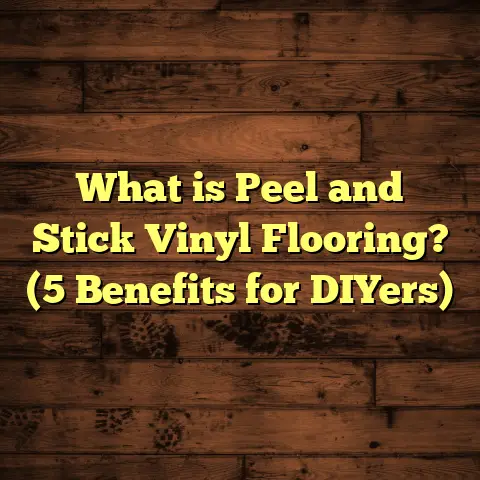What is Value Grade Hardwood Flooring? (5 Key Benefits Revealed)
When I first started installing hardwood floors years ago, I quickly realized that the choice of flooring isn’t just about looks or price. It’s a real investment—a foundational part of your home that impacts everything from comfort and style to resale value. Hardwood floors can last decades, sometimes even a lifetime, if you pick the right type and care for them properly. Early in my career, I encountered a lot of homeowners who wanted the beauty of hardwood but found premium grades way out of their budget. That’s when I learned about value grade hardwood flooring—a smart middle ground that offers real wood’s warmth and durability without breaking the bank.
If you’re curious what value grade hardwood flooring means or whether it could be right for your project, stick around. I’ll walk you through what it is, why it’s worth considering, and share stories from my years on the job that bring it to life.
What Is Value Grade Hardwood Flooring?
You might have heard about hardwood flooring being “graded,” but what does that really mean? Hardwood grading is a way to sort planks based on appearance and quality. The grading system helps buyers understand what to expect in terms of color consistency, grain patterns, presence of knots or mineral streaks, and overall visual uniformity.
Value grade hardwood flooring is classified as a lower-grade option compared to select or premium grades but still made from solid hardwood species like oak, maple, hickory, or walnut. Unlike higher grades where manufacturers pick out the most flawless boards, value grade includes more natural features like knots, mineral streaks, color variations, and irregular grain patterns.
Characteristics of Value Grade Hardwood
- Knots and Mineral Streaks: These add character but may also be seen as imperfections by some. They are natural features, not defects.
- Color Variation: Boards may have a wider range of color tones within the same batch.
- Grain Patterns: More diverse grain textures with some rougher areas.
- Dimensions: Usually standard thickness of 3/4 inch for solid hardwood; widths vary between 2 1/4 inches to 5 inches or more.
- Species: Commonly available in oak (red or white), maple, hickory, cherry, and walnut.
The presence of these traits means value grade hardwood floors have a rustic charm that can fit many design aesthetics—especially those that embrace natural, lived-in looks rather than ultra-smooth perfection.
How Does Value Grade Compare to Other Grades?
To put it simply:
- Premium/Select Grade: Nearly flawless appearance with minimal knots or color variation. Usually smoother and more uniform.
- Character Grade: Shows more knots and distinct grain patterns but still visually appealing.
- Value Grade: Contains the most knots, color variation, and other characteristics that highlight wood’s natural beauty.
Each grade has its place depending on the homeowner’s priorities. I’ve worked with plenty who prefer value grade precisely because it feels authentic and unique.
Why Choose Value Grade Hardwood?
You might wonder if choosing a lower grade means compromising on durability or longevity. The good news is that with proper installation and finishing, value grade hardwood can be just as strong and long-lasting as higher grades. The main difference lies in appearance rather than structural integrity.
The Cost Breakdown: What Can You Expect to Pay?
Price is one of the biggest reasons people gravitate toward value grade hardwood flooring. When I help clients estimate costs, I always break down materials versus labor so they see where their money goes.
Material Costs
Value grade hardwood flooring typically costs between $3 to $5 per square foot for materials alone. This is significantly less than premium grades that can run $7 to $12 or more per square foot. For example:
- In cities like Atlanta or Dallas, value grade oak usually falls in the $3.50–$4.50 range.
- In pricier markets like New York or San Francisco, expect materials closer to $4.50–$5 per square foot due to shipping and local demand.
These prices reflect solid hardwood planks about 3/4 inch thick and 2 1/4 to 5 inches wide.
Installation Costs
Labor costs vary widely based on location, existing floor conditions, subfloor preparation needs, and job complexity. On average:
- Installation runs from $3 to $7 per square foot.
- Complex patterns like herringbone or diagonal layouts increase labor time and cost.
- Removal of old flooring or repairs to subfloor add extra charges.
I once took on a project in a Boston townhouse where we had to level uneven subfloors before installing value grade maple flooring. The labor cost was on the higher end—around $7 per square foot—but the homeowners were thrilled with the final look.
Total Budget Examples
Let me share some real-world numbers from projects I’ve completed over the last few years:
| Location | Square Footage | Material Cost ($/sqft) | Labor Cost ($/sqft) | Total Estimated Cost ($) |
|---|---|---|---|---|
| Cleveland, OH | 1,200 | 3.75 | 4.00 | 9,300 |
| Austin, TX | 900 | 4.00 | 3.50 | 6,750 |
| Seattle, WA | 1,500 | 4.50 | 5.50 | 15,000 |
| Columbus, OH | 1,100 | 3.60 | 4.20 | 8,580 |
These numbers include removal of old carpet or vinyl floors in some cases but exclude major structural repairs.
Installation Timeframe: What Should You Plan For?
Timing can be a critical factor when scheduling your project. From my experience coordinating multiple installations each year:
- Acclimation Period: Hardwood planks should acclimate in your home for at least 3-5 days before installation. This prevents excessive expansion or contraction later.
- Installation Duration: For an average 1,000–1,500 square foot home with value grade hardwood installed in a straightforward pattern, expect 3-7 days.
- Finishing: If your floor requires staining or additional seal coats on site, add another day or two.
For instance, a project I managed in Denver involved installing value grade oak flooring in an open-plan living/dining area (about 800 sq ft). We acclimated the wood for four days and finished installation in three days flat.
Five Key Benefits of Value Grade Hardwood Flooring
Over hundreds of projects I’ve handled personally—and many more I’ve studied—five benefits stand out as reasons value grade hardwood is a wise choice:
1. Affordability Without Sacrificing Real Wood
It’s tempting to go for laminate or vinyl when on a tight budget because they mimic wood looks at lower prices. But those options don’t offer the warmth or longevity of real hardwood.
Value grade hardwood lets you walk on authentic wood for as little as $6–$10 per square foot installed. That’s often half the cost of premium woods but with genuine material underneath your feet.
I remember helping a young couple in Phoenix choose value grade hickory after their initial quotes for select grade exceeded their budget by thousands. They were thrilled to find a durable floor that felt natural and authentic yet affordable.
2. Unique Character Adds Charm
The natural knots and color variations in value grade planks make every board different—almost like a fingerprint for your floor.
One homeowner in Portland told me her value grade oak floor brought “life” into her home because no two boards looked alike. She appreciated how the varied grain patterns complemented her rustic furniture perfectly.
This character is something you don’t get with factory-perfect select grades or synthetic alternatives.
3. Durability That Lasts Decades
Many people worry that value grade floors won’t stand up over time due to their imperfections.
In reality, solid hardwood itself is incredibly durable regardless of grade because all planks have similar thickness (usually 3/4 inch). This thickness allows sanding and refinishing multiple times—in some cases up to five or six times—over decades.
For families with kids or pets like mine (I have two energetic dogs), this means your floors can handle daily life without losing their charm.
4. Flexibility Across Home Styles
Value grade hardwood fits a surprising range of design styles because its natural imperfections lean into organic aesthetics.
Whether your home leans farmhouse cozy or industrial chic, these floors provide an authentic backdrop that complements wood beams, brick walls, or sleek metal fixtures like no other floor type can.
I recently installed value grade walnut flooring in a Brooklyn loft and watched how it softened the modern steel elements while adding warmth underfoot.
5. Easier Repairs Mean Lower Long-Term Costs
If damage happens—a deep scratch or water stain—it’s easier to replace individual planks without worrying about matching expensive premium boards exactly.
In one case from my work in Minneapolis, a client accidentally dropped heavy furniture during moving day that scratched several boards on their value grade maple floor. Because replacement boards were affordable and readily available locally (within $4 per square foot), they swapped out just the damaged pieces without stress.
More Detailed Case Studies & Data Insights
I want to share a couple more examples from my files to give you a feel for how value grade hardwood performs across different climates and home types.
Case Study 1: Suburban Family Home — Cincinnati, OH
- Home size: 1,400 sq ft
- Species: Value grade white oak
- Finish: Matte polyurethane
- Total cost: $11,200 ($8 per sq ft installed)
- Project duration: Seven days (including acclimation)
- Outcome: After three years with kids running around daily and occasional spills, floors show minor wear but no significant damage.
- Home resale impact: Local agent estimated flooring upgrade added roughly $10k in market value.
The family loved how the knots and grain gave their living room warmth and personality without breaking their renovation budget.
Case Study 2: Urban Condo — Chicago, IL
- Home size: 850 sq ft
- Species: Value grade hickory
- Finish: Wire-brushed with satin sealant
- Total cost: $7,650 ($9 per sq ft installed)
- Project duration: Five days
- Outcome: The condo’s modern industrial design was complemented by the rustic texture of hickory boards showing plenty of character.
- Maintenance: Tenant reported easy upkeep with regular sweeping and occasional touch-up refinishing after two years.
How To Choose The Right Value Grade Hardwood For Your Home
There are some practical points I always walk clients through when selecting value grade floors:
Species Selection
Different woods behave differently:
- Oak (red vs white): White oak tends to be slightly harder and more water-resistant; red oak has warmer reddish tones.
- Hickory: Very hard and durable; great for high traffic but has striking grain patterns.
- Maple: Smooth grain with subtle character; lighter tones.
- Walnut: Darker wood with rich colors but typically higher priced even at value grade.
Plank Width and Length
Wider planks (4–5 inches) create a more open look but may show more variation from plank to plank. Narrower planks (2 1/4 inches) offer classic styling with less pronounced contrasts.
Lengths vary but longer boards (36–48 inches) reduce seams and create a cleaner look but sometimes cost more due to milling complexity.
Finish Types
Matte or satin finishes hide scratches better than glossy finishes while enhancing wood’s natural look.
Some homeowners opt for oil-based finishes that penetrate wood deeply for durability; others prefer water-based for lower odor and faster curing times.
Maintenance Tips for Value Grade Hardwood Flooring
To keep your floors looking great long-term:
- Sweep or vacuum regularly with soft bristle attachments to remove grit.
- Use furniture pads to avoid dents.
- Wipe spills immediately—especially near entrances.
- Avoid wet mopping; use damp cloths instead.
- Schedule refinishing every 7–10 years depending on wear.
Comparing Value Grade Hardwood With Other Flooring Options
You might ask: Why pick value grade hardwood over laminate or engineered wood?
Here’s my take based on years of hands-on work:
| Flooring Type | Approx Cost Installed ($/sqft) | Durability | Appearance | Lifespan |
|---|---|---|---|---|
| Value Grade Hardwood | $6–$10 | High (sand & refinish) | Authentic wood character | 40+ years |
| Laminate | $2–$5 | Moderate (no sanding) | Good imitation | 10–15 years |
| Engineered Hardwood | $5–$12 | Moderate–High | Real wood veneer | 20–30 years |
| Vinyl Plank | $2–$6 | Moderate | Varies (imitations) | 15–20 years |
Value grade hardwood wins on authenticity and longevity but requires more upfront investment and maintenance than laminate or vinyl.
Final Thoughts From My Experience
Choosing flooring is one of those decisions you live with every day—sometimes for decades. From my many projects across states like Ohio, Texas, Washington, and Illinois, I’ve seen how value grade hardwood floors give homeowners a beautiful balance of affordability, durability, and natural charm.
If you want real wood under your feet without paying premium prices but still expect quality that lasts long-term, value grade hardwood flooring is worth serious consideration. It’s an investment that pays off in comfort and style—and your future self will thank you when those floors still look great years down the road.
Planning to move forward? Using tools like FloorTally can help you get accurate cost estimates based on your location so you can budget smartly from day one.
Got questions about your specific project? Just ask—I’m happy to share what I’ve learned firsthand after all these years working with wood floors!





